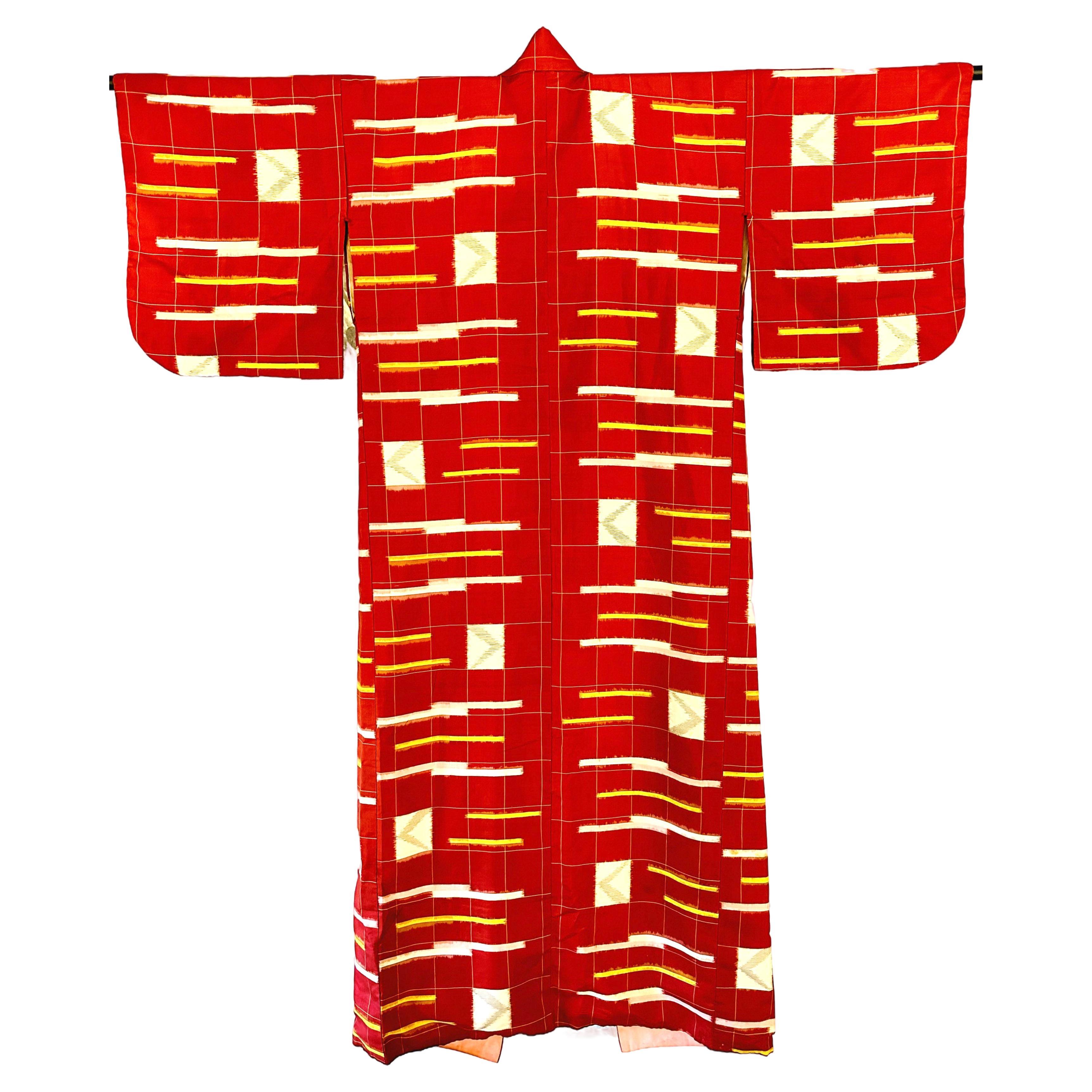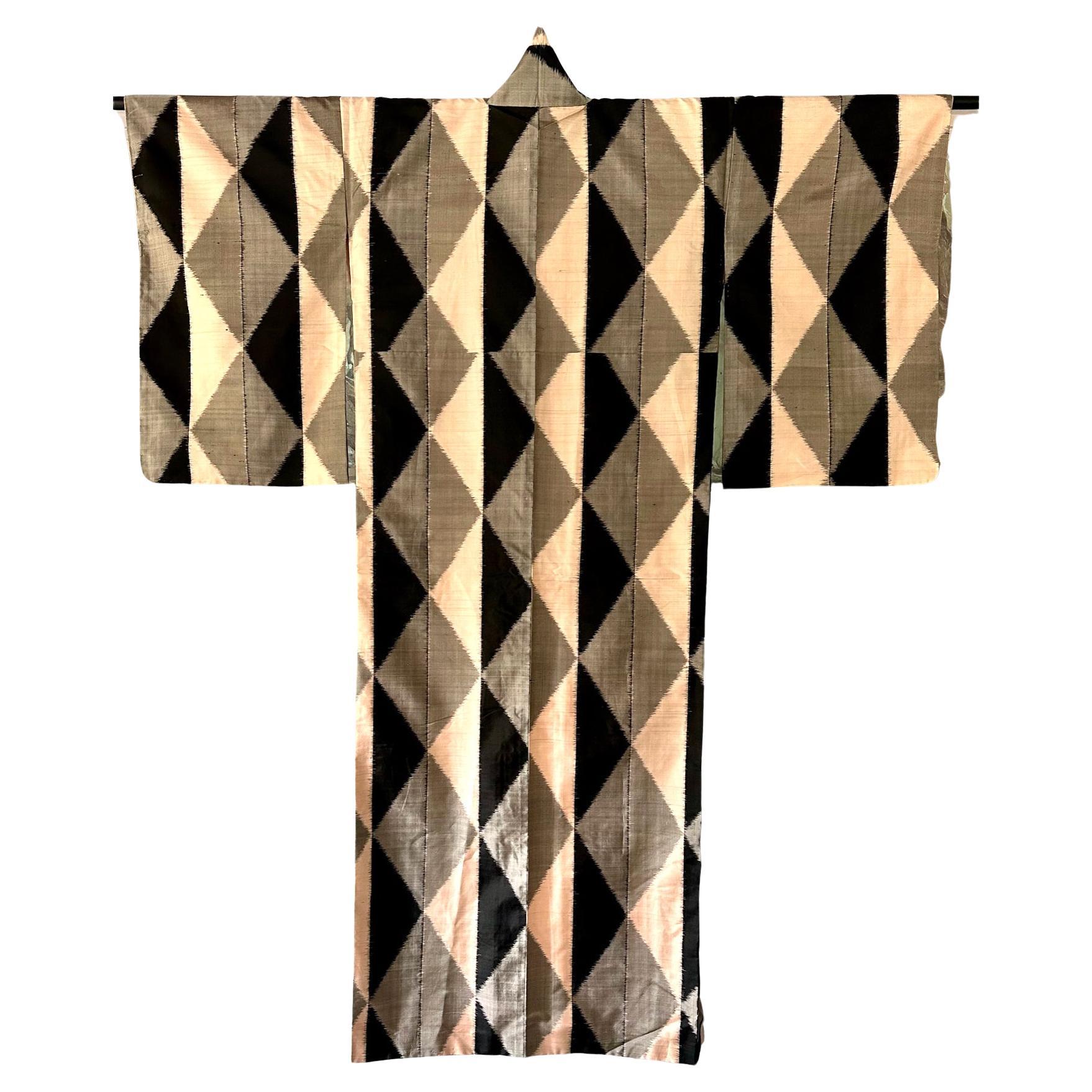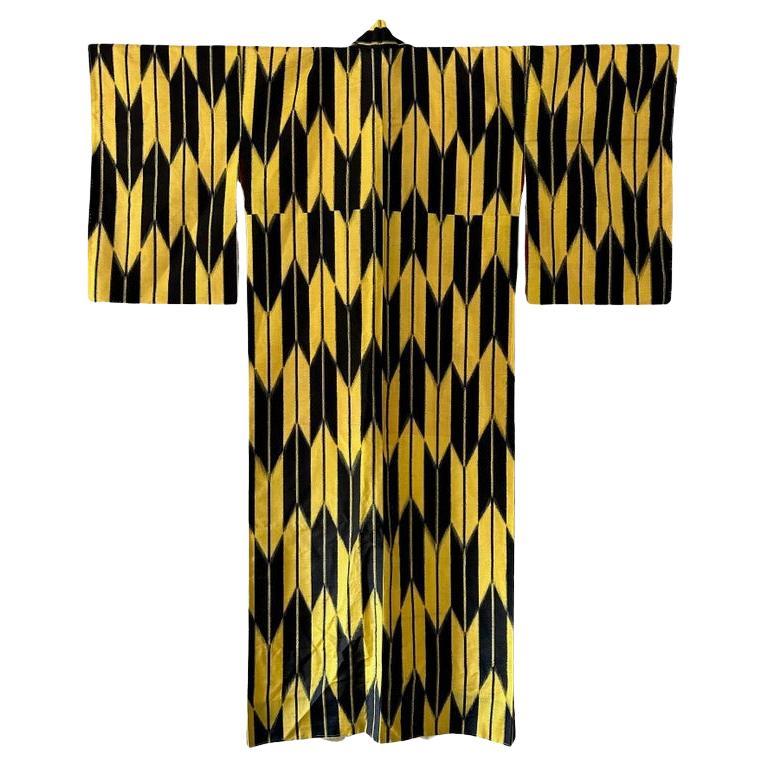Items Similar to Rare Japanese Woven Ikat Child Kimono Nemaki
Want more images or videos?
Request additional images or videos from the seller
1 of 17
Rare Japanese Woven Ikat Child Kimono Nemaki
About the Item
A rare and well preserved Japanese woven child's kimono circa early 20th century (end of Meiji period). The small kimono was a great example of Nemaki (sleepwear) for a young boy, identified by its size and distinct attached and tapered sleeves with opening under the armpits. The distinguished weaving is double-ikat (called Tate-Yoko Kasuri in Japanese), in which both wefts and warps were pre-dyed with resistant paste to create a slightly blurry edges on the squared design, both vertically and horizontally. The white square pattern covers the entire surface. The repetition, the subtle variations and the blurred images make the piece visually arresting. One of the most difficult techniques to master, the demanded precision of the pre-dye is the key to the creation. Closer inspection of the garment further reveals that it was lovely made with great details and care. Subtle plaiting was placed on the front lapel as well as the back shoulder areas. Small loops were sewn onto the chest area (for tie closure). The back of the kimono was lined with a brown fabric with ikat pattern for durability. The end of the inner sleeves was lined with dark blue silk stripes for the same purpose. The Nemaki garment was likely made for a boy of a wealthy family and wasn't used extensively based on the well-preserved condition.
For a similar boy's Nemaki kimono, see "Textile of Japan" Prestel, page 282, illustration 96.
IIkat weaving was originated in Southeast Asia and spread to Japan Mainland in the 17th century via Okinawa (14th century). The cotton production accelerated the development of the textile industry on a much larger scale by then in the Edo period when Kasuri became very popular among the general population.
- Dimensions:Height: 30 in (76.2 cm)Width: 37.5 in (95.25 cm)Depth: 1 in (2.54 cm)
- Style:Meiji (Of the Period)
- Materials and Techniques:Cotton,Ikat
- Place of Origin:
- Period:
- Date of Manufacture:Early 20th Century
- Condition:Wear consistent with age and use. Overall good condition as a well-preserved example. Little wear with minor scattered spots of stains.
- Seller Location:Atlanta, GA
- Reference Number:1stDibs: LU945034556612
About the Seller
5.0
Platinum Seller
These expertly vetted sellers are 1stDibs' most experienced sellers and are rated highest by our customers.
Established in 2006
1stDibs seller since 2010
480 sales on 1stDibs
Typical response time: <1 hour
- ShippingRetrieving quote...Ships From: Atlanta, GA
- Return PolicyA return for this item may be initiated within 2 days of delivery.
More From This SellerView All
- Japanese Vintage Indigo Woven Ikat Kasuri Textile PanelLocated in Atlanta, GAA Japanese hand-woven panel with indigo blue background with white ikat chevron and diamond pattern. Sewn together from four loom-woven narrower stripes, the large panel was likely a...Category
Early 20th Century Japanese Meiji Textiles
MaterialsCotton
- Japanese Art Deco Ikat Silk Meisen KimonoLocated in Atlanta, GAA striking and well preserved Japanese Meisen kimono hand-sewn from woven Ikat Silk circa 1920-40s (Taisho to Showa period). The kosode style kimono (sma...Category
Early 20th Century Japanese Showa Textiles
MaterialsSilk
- Japanese Art Deco Ikat Silk Meisen KimonoLocated in Atlanta, GAA well preserved Japanese Meisen kimono hand-sewn from woven Ikat Silk circa 1920-30s (Taisho to early Showa period). The kosode style kimono (small slee...Category
Early 20th Century Japanese Showa Textiles
MaterialsSilk
- Japanese Art Deco Ikat Silk Meisen KimonoLocated in Atlanta, GAA well preserved Japanese Meisen kimono hand-sewn from woven Ikat Silk circa 1920-30s (Taisho to early Showa period). The kosode style kimono (small slee...Category
Early 20th Century Japanese Showa Textiles
MaterialsSilk
- Japanese Woven Linen Kimono with Katazome Stencil DyesLocated in Atlanta, GAOn offer is a Japanese summer kimono woven from indigo blue linen with ivory color fine stripes patterns with apparently darker weft additions. The elega...Category
Early 20th Century Japanese Japonisme Textiles
MaterialsLinen
- Japanese Indigo Kasuri Ikat Traveling CapeLocated in Atlanta, GAKnown in Japanese as Bozugappa (priest's raincoat), this cape-like garment was worn by the travelers in Japan circa late 19th century to early 20th century (end of Meiji period). Derived from the cape worn by the Portuguese missionary, who first arrived in Japan in mid-16th century, this type of cape was originally reserved for the Japanese military...Category
Antique 1890s Japanese Meiji Textiles
MaterialsCotton, Linen
You May Also Like
- Japan USA Rare 1930 Sports KimonoLocated in South Burlington, VTUnique Sports Collectible Opportunity- Immediately Frameable "Happi with International Olympic athletes sending off cheering song for 1932 Los Angles...Category
Early 20th Century Japanese Showa Sculptures and Carvings
MaterialsCotton
- Early 20th Century Woman’s Double Ikat Bingo-Gasuri Kimono, JapanLocated in Point Richmond, CACotton double ikat kimono, Japan, Early 20th Century A graphically compelling example of a Bingo-gasuri kimono, produced in Hiroshima Prefecture, Japan. ...Category
Early 20th Century Japanese Taisho Textiles
MaterialsCotton
- Vintage Embroidered Japanese Ceremonial Child's Kimono in a Gold Bamboo FrameLocated in Stamford, CTBeautiful rare vintage hand sewn one of a kind Japanese ceremonial child's kimono in a gold bamboo framed shadowbox. Kimono for children are shaped and styled much like those for adults, but are almost always in bright patterns and prints. This is a great example of a child's kimono used...Category
Mid-20th Century Japanese Shadow Boxes
MaterialsBrocade, Silk
- Japanese Wedding KimonoLocated in Santa Cruz, CAVintage "uchikake" Japanese Wedding Kimono. The Kimono is handmade embroidered silk fabric featuring cranes. Age - Showa Period, late 20th Century, 1970's, of the period. Dimens...Category
Mid-20th Century Japanese Showa Textiles
MaterialsSilk
- Meiji Period Japanese Indigo Double Ikat Futon CoverLocated in Point Richmond, CAMeiji period Japanese Indigo double ikat futon cover Japanese futon cover, a double ikat pattern in four panels depicting Kumamoto Castle with im...Category
Antique 1890s Japanese Meiji Textiles
MaterialsCotton
- Framed Embroidered Japanese KimonoLocated in Nashville, TNJapanese gold couched thread embroidered scene of two shellfish on a black silk kimono remnant. Mounted inside a gilt frame. Circa 1890-1900.Category
Antique 1890s Japanese Japonisme Textiles
MaterialsSilk
Recently Viewed
View AllMore Ways To Browse
Tibet Pillows
Orley Shabahang Persian Wood Blocks
Ottoman Era Embroidery
Pictorial Embroidered Panel Gold Thread
Small Khmer Rituals Cloths Cambodia
Tapis Lampung
Yogi Kimono
Alessio Nessi
Fine Vintage Blue Kuro
Hanae Mori Lynx
Japanese Meiji Embroidered Lions Wall Hanging
Tapestries 898
Mid Century Embroidered Silk Brocade
Ikebana Book
Vintage Red Silk Brocade Japanese Ceremonial Kimono
Uzbek Robe
Bhutanese Kira
Buddha Tapestry





